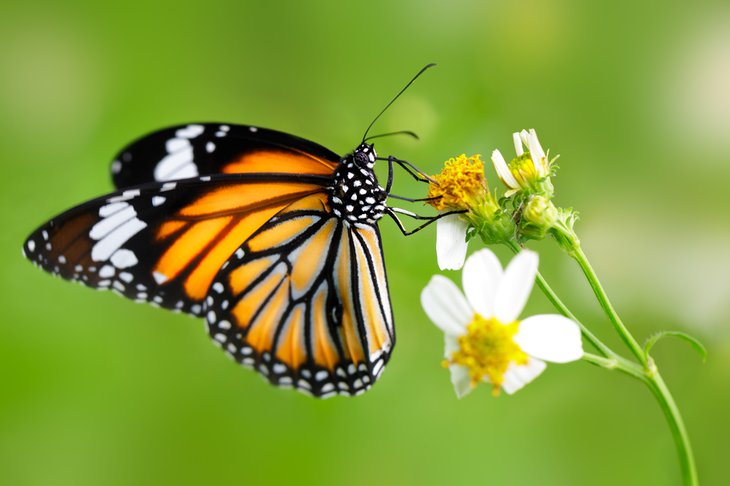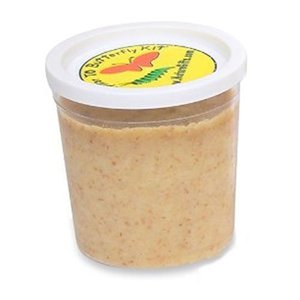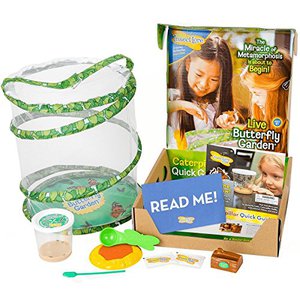Monarch Food
Updated
For all living things, food is essential for survival. Whether it is plants or animals, without sufficient food, the population can’t thrive. While there are many modes of food absorption for every group of organisms, this article focuses on what the Monarch caterpillar and the Monarch butterfly eats. So, what do the caterpillars eat? What do Monarch butterflies eat?
The Monarch feeds on solid food in its caterpillar stage and, after it transforms into an adult, it feeds on liquid food.

The Monarch butterfly undergoes complete metamorphosis as it grows from an egg to an adult, the process being egg to caterpillar , caterpillar to chrysalis, and finally, the chrysalis becomes an adult butterfly. Complete metamorphosis means that the form and shape of an organism gradually change while it continues to develop. In the case of the Monarch butterfly, the body form and features of the caterpillar are visibly different from the adult.
Besides the difference in appearance between the caterpillar and the adult Monarch, the mode of feeding and the type of food that the two eat are completely different. The caterpillar has strong jaws adapted for crushing and chewing solid food, while the butterfly has a proboscis adapted for siphoning liquid food. We are going to categorically describe the types of food that the Monarch eats as a caterpillar and as an adult.
What do Monarch Caterpillars Eat?
Monarch caterpillars are uniquely designed to specifically feed on one plant, the milkweed. This explains why the Monarch butterfly is also known as the milkweed butterfly. This wonderful plant is the reason why the Monarch butterfly has been proven beyond doubt to be the most beautiful butterfly in the world. But why the milkweed and not any other plant?
The milkweed plant is a perennial plant that exists in a number of varieties, including the swamp milkweed, the common milkweed, and the California milkweed, all of which the Monarch butterfly is attracted to. These varieties are native to many different areas of the world and they thrive depending on the weather conditions of an area. That is why, when purchasing a milkweed, gardeners advise you to choose one that is native to your area. That way, it will be more suited to the existing climate and weather conditions in your area. The milkweed plant pairs well with other flowering plants because it does not spread and it is also quite easy to grow as it does not require any special maintenance.
If you want to attract Monarch butterflies to your home or want to raise them indoors with the help of a Monarch butterfly kit , ensure that you have enough milkweed to sustain them. Researchers have found that that one caterpillar feeds on approximately 20 leaves of milkweed per day. When the milkweed is newly purchased as a shoot, it takes two months for it to develop and become a sufficient food source for caterpillars.
The milkweed plant blooms beautiful flowers with a vanilla scent that attracts the Monarch butterflies to feed on its nectar. The adult butterfly proceeds to lay its eggs on the leaves of this particular plant. They lay their eggs on the milkweed to secure the future of the caterpillar that will hatch out of that egg by ensuring that as soon as it is hatched, it has a ready supply of food.
Surprisingly, the milkweed contains all the nourishment that a caterpillar needs. It is such a good food source for caterpillars that as soon as it is ready for the next stage of its life cycle, it is 2,000-2,700 times its original size, and this weight is achieved through exclusive feeding on the milkweed leaves. The plant also protects the egg. The butterfly lays the egg on the underside of the leaf, where it is not easily detected by predators. It is also protected by the leaf from direct sunlight and kept free from direct rainfall. The question still remains, though; why the milkweed?
It is important to note that the milkweed is poisonous, not only to humans but also to other organisms in the wild. It is toxic when it comes into contact with the human eye. Caterpillars of the Monarch butterfly are immune to the poison. While the Monarch butterfly ingests the poisonous plant, it becomes poisonous too. This is one of the many ways in which the milkweed is basically the “guardian angel” of the Monarch butterfly. Why? When the Monarch butterfly becomes poisonous, this only means that predators are less likely to eat it. Consuming the milkweed makes the butterfly distasteful to predators. The milkweed diet also gives the butterfly a particularly vibrant orange color, making the butterfly easy to detect from afar, so that the predators will know to stay clear of it.
You might be wondering why the milkweed is such a friendly plant to the Monarch butterfly. Well, it is quite simple. The milkweed and the Monarch butterfly have a symbiotic relationship with each other. Symbiosis occurs in a mutual interaction where two organisms benefit from each other. Because the Monarch butterfly is free from predators and enjoys feeding on the sweet nectar that the milkweed provides, it helps the plant by spreading its pollen to other milkweed plants. Pollination is necessary for milkweed reproduction and variation, where more productive milkweed offspring is attained, ensuring that there is more milkweed available for the future generations of the Monarch butterfly.
Challenges of the Milkweed
In all things in nature, there are advantages and disadvantages, and recently, there is trouble in paradise as the milkweed plant is on the road to extinction. This automatically means that the Monarch butterfly is an endangered species as well. The milkweed has the possibility of becoming extinct due to a number of reasons. First, the Oyamel fir forest in Mexico is slowly disappearing.
The Monarch butterfly is a migrating species. During the winter, it flies to California or Mexico. Its largest habitat in Mexico is the Oyamel forest , which usually has an incredible bloom of flowers. But there has been constant air pollution near the forest and the cutting of timber for industrial purposes. The bark beetle infestation on the milkweed plants is also alarming. If care is not taken, the forest will not exist much longer.
Additionally, chemicals are being used to replace manual weeding on most farms. Some of these weed-killer chemicals are non-selective and they kill any plant, including milkweed. Without milkweed preservation, it could become a nearly extinct species.
Remedies to the Challenge
The reasons above are just a few of the many ways in which the milkweed could disappear. Scientists and plant breeders are taking measures to ensure that the Monarch butterfly does not disappear with the milkweed. Scientists are researching what other sources of food exist for the Monarch caterpillar. Recently, there has been an interesting development. Monarch butterflies are feeding on fresh cucumber skin and pumpkin pieces for their nourishment.
Although the pumpkin and cucumber trial is good progress, the extinction problem is still a possibility until scientists can find a plant where the adult Monarch butterfly lays eggs and the caterpillar hatched can gain nourishment from the same plant.
What do Monarch Butterflies Eat?
As stated earlier, the adult Monarch butterfly is completely different from the caterpillar. In its adult form, the butterfly has a straw-like structure located at the base of the head, which it unfolds to suck or siphon nectar from flowers and water from leaves and ponds and then fold it back when it is done feeding.
As soon as the butterfly emerges from its chrysalis and its wings are strong enough, it has to fly around in order to feed. The first flower that it feeds on is the milkweed flower, and then it proceeds to get food elsewhere. Milkweed is also very important for the survival of the adult butterfly. When the butterfly drinks nectar from the milkweed flowers, it becomes poisonous, meaning that no predators will want to eat it.
The Monarch butterfly is also a migrating species. In order to ensure the Monarch butterflies’ survival, there are more than 20 varieties of milkweed plants located in different regions all around the United States, where the butterflies can feed, lay eggs, and protect themselves from predators.
Common Sources of Food
The Monarch butterfly, however, does not survive solely on nectar . Sometimes, it can be seen sucking juice from pieces of freshly cut fruits, specifically watermelons, bananas, and oranges. Because nectar is a sugary liquid, the juices from these fruits serve as suitable substitutes. Peach and tangerine can also be fed to the butterfly, though rarely.
Additional flowers that the Monarch butterfly feed on are lilacs and goldenrods. The adult Monarch butterfly is relatively large. It, therefore, needs to feed on flowers that are all large with flat surfaces that they can perch or sit on while feeding. Besides flowers, some other plants also serve as sources of food for the Monarch butterfly. The wild carrot, the red clover, thistles, and the alfalfa plant are all great food sources.
The male butterflies have a way of getting nutrients directly from the ground. They simply place their body on the ground when it is muddy and moist. By doing this, they are able to absorb moisture directly from the earth. This process is known as mud-puddling.
If you are growing butterflies in a kit, the first food that you should give them immediately after emergence is sugar water, which provides the butterfly with energy. The appropriate amount is one part sugar with four parts water. When the butterflies are strong enough, you can then introduce the fruits and then fresh flowers or let them fly out depending on the temperature.
Conclusion
The Monarch butterfly also faces the danger of extinction not only because of the decreasing population of the milkweed, but also due to recent changes in weather patterns that lead to untimely weather events, such as strong winds, hail, and freezing temperatures. These unforeseen temperatures affect the Monarch butterflies on the ground and even during migration.
Ensuring that the butterflies have enough food and energy will aid greatly in helping them survive the harsh weather. It is therefore important to provide the Monarch butterfly with enough food from the point at which they start feeding.
What do Monarch butterflies eat? Caterpillars have to be in a place with enough milkweed to take them through the cycle before they become chrysalises. During the fifth instar, you can introduce some fresh pumpkins and cucumber to them. The adult Monarch butterflies should never be allowed to stay hungry or feed less than they want as they require maximum energy for egg laying and mating. They do best with a plentiful diet of nectar, sugar water, or fruit juices.
Featured Articles
-

Butterfly School Kits
Find the best recommendations for a butterfly school kit and refill kits.
-

Butterfly Lifespan
How long do butterflies live? Read about the butterfly lifespan and how you can overwinter butterflies.
-

Butterfly Kits
Learn how to grow butterflies from caterpillar to adulthood with the best caterpillar to butterfly kit.
Recent Articles
-

Monarch Butterfly Facts
Read about amazing Monarch butterfly facts!
-

Monarch Migration
Discover the Monarch migration map and the timing and generations of how these butterflies migrate.
-

Monarch Food
What do Monarch butterflies eat? Learn the different food sources of the Monarch caterpillar and butterfly.
-

Monarch Butterfly Kit
Learn how to raise Monarch caterpillars into butterflies with the best Monarch butterfly kit models.
-

Caterpillar Life Cycle
Learn about the caterpillar stages of growth. Each step in the caterpillar cycle brings new changes!
-

Monarch Chrysalis
Discover the amazing transformation that takes place inside the Monarch chrysalis!
-

Monarch Lifespan
How long do Monarch butterflies live? Find out as we explore each stage of the Monarch lifespan.
-

Monarch Butterfly Life Cycle
Read about the 4 stages of the Monarch butterfly life cycle and how can you help them thrive.
-

Butterfly Cycle
Discover the wonder of the butterfly life cycle from egg to caterpillar to chrysalis to adult
-

Monarch Caterpillar
Discover the lifecycle of the Monarch caterpillar and butterfly!
-

Butterfly Hatching
Discover what happens and what leads up to a butterfly hatching from its chrysalis.
-

Monarch Poisonous
Are Monarch butterflies poisonous? Find out where they get their poisons and how toxic it really is!

